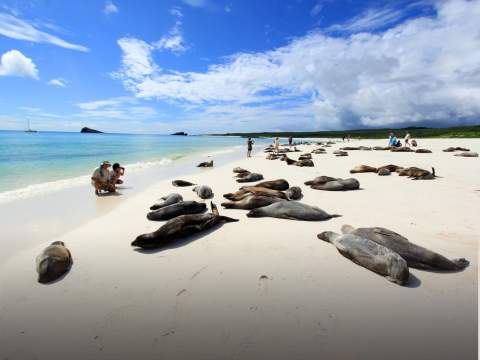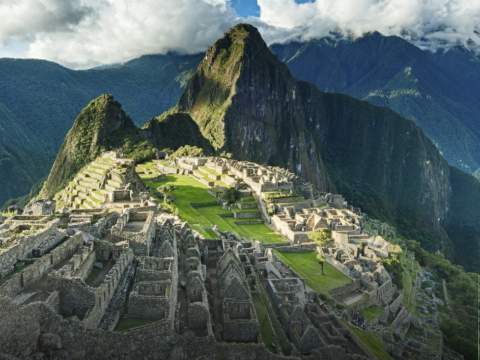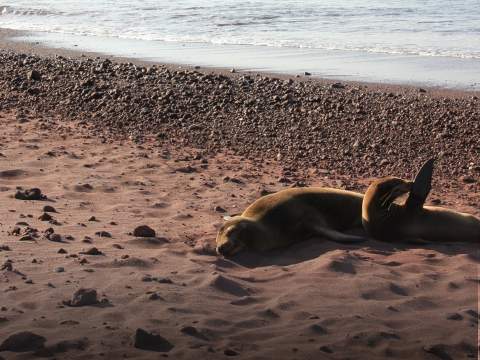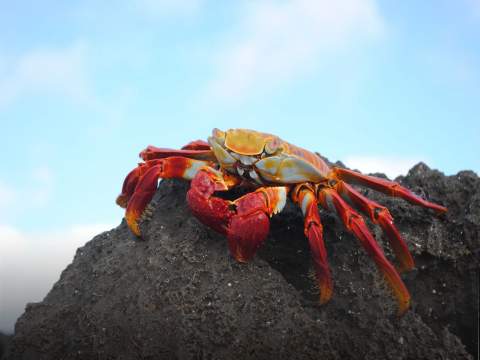Weather
Description:
PERU
Peru is a diverse country. With beaches, mountains, rainforest and desert, there is no off-season. But it does pay to know a bit about where you're going, and what you'll need on your Peru tour:
The Andes - Though officially part of the dry season, April and May are considered the Andean spring, while June through October marks the Andean summer. Mid-day temperatures range from 70 to 80 F in the sun. Nighttime temperatures in Cusco range in the 40s F and can dip into the 30s F. Weather is usually clear in the morning with clouds accumulating in the afternoon. Rain can happen in any season, so quality rain gear is essential.
The Amazon - A rainforest environment, the Peruvian Amazon has varied weather conditions and frequent unpredictable rain showers. It is generally hot and humid during the day with more comfortable temperatures through the night. Daytime high temperatures average between 82° and 93° F, and the average nighttime low is between 62° and 73°. Nevertheless, in some areas cold fronts can sweep into the Amazon and push daytime high temperatures down to 50° F and nighttime lows to 43° F. Any time of year, one should always be prepared for cooler temperatures and rain showers. Around 80% of the annual average 79 inches of rainfall occurs during the rainy season (December through March) when heavy rain may continue for hours or days.
Year Round Temperatures in °F, Rainfall in Inches
GALAPAGOS
The great weather of the Galapagos Islands makes them a fantastic destination for travel year-round. Every month of the year is a good time to enjoy a tour of the region. The Galapagos Islands have a subtropical climate that is almost completely determined by sea currents. Although most believe the Galapagos to be a very hot destination, the cool water currents in the area keep the climate more temperate year-round. The islands’ equatorial location ensures twelve hours of sunlight daily, all year long. The mild variations in weather from month to month result in an overall climate of warm days, cool nights and low humidity. Anytime is a great time to travel to the Galapagos; while visiting one can expect to see plenty of sunshine, blue skies and a possible chance of light rain.
There are two seasons in the Galapagos:
- The hot or rainy season arrives with the coming of the warm Panama current. The warmest months are December through June with temperatures ranging from 72-90°F (22-32°C), with February and March being the hottest and sunniest. The sea is at its warmest (in the 70°F range) and tends to be calmer during this time. Although the islands receive slightly more rainfall during these months, most of the lower elevations remain quite arid. Expect blue skies and sunshine and with a chance of short afternoon showers.
- July through November is the dry or garua season, which begins with the arrival of cold ocean currents. One can expect cooler temperatures and a light mist in the morning during these months. The skies are also a bit cloudier and air temperatures a bit cooler, in the range of 60-75°F (15-24°C). The garua is a mist that forms in the highlands, providing moisture and usually tapering off by midday, leaving skies slightly overcast or sunny for the afternoon. The air temperature can be slightly lower, but the Equator is still a warm place to visit. During this time of year a cold ocean current from the south, called the Antarctic Humboldt current, causes the water temperature to drop slightly, ranging from 60°F- 72°F (15-22°C).
Within both seasons, there are other variants, like altitude, that affect the weather.
The lowest point of elevation is sea level and the highest is Wolf Volcano, Isabela Island (5,600ft or 1,710m). There are seven vegetation zones ranging from arid coastal zones to evergreen cloud forests to treeless shrubless pampa zones, all of which are affected by moisture levels, temperature and sunlight. During the garua season, the coast is very dry while the highlands are much wetter. The hot season may or may not have a rainy period which normally lasts four to six weeks, or in the event of El Nino, a longer period. During the hot season, the coastal zones remain arid. Prevailing winds from the southeast keep the southern sides of the major islands much moister then the northern sides, which fall into a rain shadow resulting in the arid zones reaching a much higher elevation. The months of May and December are changeover periods and weather and sea temperatures in these months tend to vary from year to year depending on the change in the water currents. Occasionally, one will feel humidity, predominantly on the south side of major islands. Compared to the humidity levels in the Amazon or the US South, the humidity in the Galapagos is very low and will not disturb activities.
Snorkeling is an activity offered on all Galapagos trips.
Wetsuits, available onboard most cruises and for all land tours, are recommended June through November. Though sea temperatures vary significantly from island to island, generally all travelers will use a wetsuit during this time. Snorkeling in shallow waters offshore or in protective coves tends to be warmer. Waters to the north, near Genovesa are warmed by the Panama Current, whereas snorkeling off the western island of Isabela is always chilly due to the cold Cromwell undercurrent. The Humboldt Current, or the South Equatorial Current, brings cold sub-Antarctic water that flows through the archipelago eight or nine months a year keeping sea temperatures low. One will experience a variance in sea temperatures while snorkeling on any trip during any time of the year. During the hot season, travelers tend to spend more time in the water, especially at midday when the temperatures are the hottest and wildlife is less active. Snorkeling is an optional activity and those who are not interested in snorkeling have other options.
Sea Conditions are a concern of many cruise travelers.
All Galapagos vessels are small; the largest accommodates only 100 passengers. Naturally, some movement will be felt on all vessels regardless of the time of year or the size of the vessel. The seas around the Galapagos are generally shallow and despite being the crossroads of several currents, the waters are not terribly rough. The seas are at their calmest January through April. December, May and June are transitional months during which one will experience relatively calm seas, though it varies year to year depending on the shift in the currents. July through November, one will find choppier seas, with August through October being the roughest. Certain vessels are more stable than others and cabin location can also help avoid seasickness. Most travel is done at night while passengers are sleeping with the only exception being the short midday transit (two hours or less). During the day, vessels dock in calm waters near shore. Passengers spend most of the day on land or snorkeling. These factors lessen the risk of seasickness. We recommend that you bring over-the-counter or prescription motion sickness medication, though many cruisers discover that the seas are much calmer than anticipated. If you are concerned about motion sickness, please contact us for more details on how to select the right vessel for you.
GALAPAGOS ISLANDS | Min-Max Air Temp | Avg Rainfall |
| JAN | 70-84 | 1.0 |
| FEB | 74-86 | 1.0 |
| MAR | 73-88 | 2.0 |
| APR | 72-86 | 1.5 |
| MAY | 72-82 | 0.8 |
| JUN | 66-78 | 0.3 |
| JUL | 67-76 | 0.5 |
| AUG | 64-75 | 0.3 |
| SEP | 62-75 | 0.5 |
| OCT | 64-77 | 0.3 |
| NOV | 66-78 | 0.5 |
| DEC | 68-80 | 0.5 |
*Year Round Temperatures in °F, Rainfall in Inches
QUITO | Min-Max Air Temp | Avg Rainfall |
| JAN | 50-66 | 4.5 |
| FEB | 50-66 | 5.1 |
| MAR | 50-66 | 6.0 |
| APR | 51-66 | 6.9 |
| MAY | 51-66 | 4.9 |
| JUN | 49-67 | 1.9 |
| JUL | 49-67 | 0.8 |
| AUG | 49-67 | 1.0 |
| SEP | 49-68 | 3.1 |
| OCT | 49-67 | 5.0 |
| NOV | 49-67 | 4.3 |
| DEC | 50-66 | 4.1 |
*Year Round Temperatures in °F, Rainfall in Inches
LIMA | Min-Max Air Temp | Avg Rainfall |
| JAN | 68-79 | 0.0 |
| FEB | 69-80 | 0.0 |
| MAR | 69-80 | 0.0 |
| APR | 67-76 | 0.0 |
| MAY | 63-72 | 0.0 |
| JUN | 61-69 | 0.1 |
| JUL | 60-67 | 0.2 |
| AUG | 60-66 | 0.1 |
| SEP | 60-67 | 0.1 |
| OCT | 60-69 | 0.1 |
| NOV | 62-72 | 0.0 |
| DEC | 64-76 | 0.0 |
*Year Round Temperatures in °F, Rainfall in Inches
CUSCO | Min-Max Air Temp | Avg Rainfall |
| JAN | 44-65 | 6.3 |
| FEB | 44-65 | 5.2 |
| MAR | 43-66 | 4.3 |
| APR | 41-67 | 1.8 |
| MAY | 39-67 | 0.3 |
| JUN | 33-66 | 0.1 |
| JUL | 32-66 | 0.2 |
| AUG | 35-67 | 0.3 |
| SEP | 39-68 | 0.9 |
| OCT | 42-69 | 1.9 |
| NOV | 43-69 | 3.1 |
| DEC | 44-69 | 4.7 |
*Year Round Temperatures in °F, Rainfall in Inches
PUNO | Min-Max Air Temp | Avg Rainfall |
| JAN | 38-62 | 5.2 |
| FEB | 38-62 | 4.3 |
| MAR | 38-62 | 3.8 |
| APR | 33-62 | 1.5 |
| MAY | 25-62 | 0.4 |
| JUN | 19-61 | 0.1 |
| JUL | 18-61 | 0.1 |
| AUG | 22-63 | 0.2 |
| SEP | 29-64 | 0.8 |
| OCT | 33-65 | 1.5 |
| NOV | 35-66 | 2.0 |
| DEC | 37-64 | 3.6 |
*Year Round Temperatures in °F, Rainfall in Inches
PUERTO MALDONADO | Min-Max Air Temp | Avg Rainfall |
| JAN | 71-88 | 13.6 |
| FEB | 70-87 | 12.8 |
| MAR | 70-88 | 11.9 |
| APR | 69-87 | 6.1 |
| MAY | 66-86 | 4.2 |
| JUN | 63-84 | 2.3 |
| JUL | 62-85 | 2.2 |
| AUG | 64-88 | 2.5 |
| SEP | 66-90 | 3.9 |
| OCT | 69-90 | 6.5 |
| NOV | 70-89 | 9.3 |
| DEC | 70-88 | 12.1 |
*Year Round Temperatures in °F, Rainfall in Inches
When to Visit
August:
September:
October:
November:
December:
January:
February:
March:
April:
May:
June:
July:
FAQ
Question:
Answer:
Question:
Answer:
Question:
Answer:
Question:
Answer:
The most traveled section of Peru, where Cusco and Machu Picchu are locate, also has a dry season (April – October) and a rainy season (November – March) with daytime temperatures in the 60s and 70s and lows in the 40s. Rainfall and temperatures vary in other regions depending on season and elevation. Please see the weather tab on your specific trip for more details.
Question:
Answer:
Question:
Answer:
Question:
Answer:
Question:
Answer:
Question:
Answer:
Question:
Answer:
All guides on Galapagos cruises are freelance and hired directly by the vessels. Guides on any of the cruises we offer will be experienced, fluent in English and hold a degree in a related area. Cruises that are mid-range or above will have the best guides possible. Our more economical options will also have great guides, but they may have a little less experience or have slightly more basic English skills. Please note that many of the best guides in the Galapagos now choose to skip formal certification process that defines the level of each guide because of the high costs and the time it demands. Because of this, the designations of Level I, II, III are no longer an accurate indicator of the quality of your guide.


















